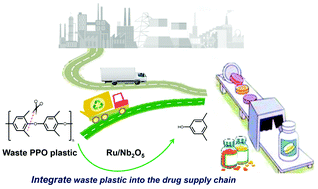Plastic waste to drug intermediate: targeted cleavage of C–O bonds in polyphenylene oxide to 3,5-dimethyl phenol†
Abstract
While making fuels and chemicals via plastic upcycling has become an important research topic recently, integrating waste plastic into the drug supply chain is exceedingly rare. Here, starting from polyphenylene oxide plastic, the selective production of 3,5-dimethyl phenol as an important pharmaceutical intermediate was achieved over Ru/Nb2O5, which is the first example of integrating waste plastic into the drug supply chain. It is found that the small-sized Ru particles and the Brønsted acid sites play key roles in the selective production of 3,5-dimethyl phenol. One the one hand, the small-sized Ru particles on 0.05% Ru/Nb2O5 inhibit the saturation of the aromatic ring (no ring saturation products were detected) and the removal of the phenolic hydroxyl group, resulting in a high selectivity to phenolic products. On the other hand, the Brønsted acid sites in Ru/Nb2O5 can stabilize the carbocation intermediates in the C(o)–O cleavage process, affording a distinct selectivity to 3,5-dimethyl phenol. This catalyst was also capable of handling common polyphenylene oxide plastics to selectively prepare 3,5-dimethyl phenol, adding new options for the synthesis of 3,5-dimethyl phenol.

- This article is part of the themed collection: 2021 Green Chemistry Hot Articles


 Please wait while we load your content...
Please wait while we load your content...